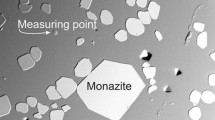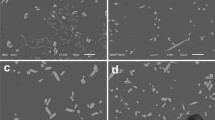Abstract
Hydrothermal experiments were carried out at 2 kbar water pressure, 700 °–800 ° C, with the objective of determining the level of dissolved Zr required for precipitation of zircon from melts in the system SiO2-Al2O3-Na2O-K2O. The saturation level depends strongly upon molar (Na2O + K2O)/Al2O3 of the melts, with remarkably little sensitivity to temperature, SiO2 concentration, or melt Na2O/ K2O. For peraluminous melts and melts lying in the quartz-orthoclase-albite composition plane, less than 100 ppm Zr is required for zircon saturation. In peralkaline melts, however, zircon solubility shows pronounced, apparently linear, dependence upon (Na2O + K2O)/Al2O3, with the amount of dissolvable Zr ranging up to 3.9 wt.% at (Na2O + K2O)/Al2O3 = 2.0. Small amounts (1 wt.% each) of dissolved CaO and Fe2O3 cause a 25% relative reduction of zircon solubility in peralkaline melts.
The main conclusion regarding zirconium/zircon behavior in nature is that any felsic, non-peralkaline magma is likely to contain zircon crystals, because the saturation level is so low for these compositions. Zircon fractionation, and its consequences to REE, Th, and Ta abundances must, therefore, be considered in modelling the evolution of these magmas. Partial melting in any region of the Earth's crust that contains more than ∼ 100 ppm Zr will produce granitic magmas whose Zr contents are buffered at constant low (< 100 ppm) values; unmelted zircon in the residual rock of such a melting event will impart to the residue a characteristic U- or V-shaped REE abundance pattern. In peralkaline, felsic magmas such as those that form pantellerites and comendites, extreme Zr (and REE, Ta) enrichment is possible because the feldspar fractionation that produces these magmas from non-peralkaline predecessors does not drive the melt toward saturation in zircon.
Zircon solubility in felsic melts appears to be controlled by the formation of alkali-zirconosilicate complexes of simple (2:1) alkali oxide: ZrO2 stoichiometry.
Similar content being viewed by others
References
Bowden, P.: Zirconium in Younger Granites of Northern Nigeria. Geochim. Cosmochim. Acta 30, 985–993 (1966)
Bowen, N.L.: Phase equilibria bearing on the origin and differentiation of alkaline rocks. Am. J. Sci. 243A, Daly vol., 75–89 (1945)
Buma, G., Frey, F.A., Wones, D.R.: New England granites: Trace element evidence regarding their origin and differentiation. Contrib. Mineral. Petrol. 31, 300–320 (1971)
Carmichael, I.S.E., McDonald, A.: The geochemistry of some natural acid glasses from the North Atlantic tertiary volcanic province. Geochim. Cosmichim. Acta 25, 189–222 (1961)
Carmichael, I.S.E., MacKenzie, W.S.: Feldspar-liquid equilibria in pantellerites: An experimental study. Am. J. Sci. 261, 382–396 (1963)
Carmichael, I.S.E., Turner, F.J., Verhoogen, J.: Igneous petrology. New York: McGraw-Hill Book Company 1974
Chao, E.C.T., Fleischer, M.: Abundance of zirconium in igneous rocks. Rept. 21st Intern. Geol. Congr. Norden. Part 1. pp. 106–131 (1960)
Cotton, F.A., Wilkinson, G.: Advanced inorganic chemistry. New York: John Wiley Interscience 1972
Dietrich, R.V.: Behavior of zirconium in certain artificial magmas under diverse P-T conditions. Lithos 1, 20–29 (1968)
Goldschmidt, V.M.: Geochemistry. Oxford: Clarendon Press 1954
Larsen, L.: Measurement of solubility of zircon (ZrSiO4) in synthetic granitic melts. Eos. 54, 479 (1973)
McCarthy, T.S., Kable, E.J.D.: On the behavior of rare-earth elements during partial melting of granitic rock. Chem. Geol. 22, 21–29 (1978)
Nagasawa, H.: Rare earth concentrations in zircons and apatites and their host dacites and granites. Earth Planet. Sci. Lett. 9, 359–364 (1970)
Nagasawa, H., Schnetzler, C.C.: Partitioning of rare earth, alkali and alkaline earth elements between phenocrysts and acidic igneous magma. Geochim. Cosmochim. Acta 35, 953–968 (1971)
Nance, W.B., Taylor, S.R.: Rare earth element patterns and crustal evolution -1. Australian post-Archean sedimentary rocks. Geochim. Cosmochim. Acta 40, 1539–1552 (1976)
Nicholls, J., Carmichael, I.S.E.: Peralkaline acid liquids: A petrological study. Contrib. Mineral. Petrol. 20, 268–294 (1969)
Nockolds, S.R., Allen, R.: The geochemistry of some igneous rock series. Geochim. Cosmochim. Acta 4, 105–142 (1953)
Poldervaart, A.: Zircon in rocks. 2. Igneous rocks. Am. J. Sci. 254, 521–554 (1956)
Schnetzler, C.C., Philpotts, J.A.: Partition coefficients of rare earth elements between igneous matrix material and rockforming mineral phenocrysts — II. Geochim. Cosmochim. Acta 34, 331–340 (1970)
Siedner, G.: Geochemical features of a strongly fractionated alkali igneous suite. Geochim. Cosmochim. Acta 29, 113–137 (1965)
Turekian, K.K., Wedepohl, K.H.: Distribution of the elements in some major units of the Earth's crust. Geol. Soc. Am. Bull. 72, 175–192 (1961)
Tuttle, O.F., Bowen, N.L.: Origin of granite in light of experimental studies in the system NaAlSi3O8-KAlSi3O8-SiO2. Geol. Soc. Am. Mem. 74, 153pp. (1958)
Wager, L.R., Mitchell, R.L.: The distribution of trace elements during strong fractionation of basic magmas: a further study of the Skaergaard intrusion. Geochim. Cosmochim. Acta 1, 129–209 (1951)
Author information
Authors and Affiliations
Rights and permissions
About this article
Cite this article
Watson, E.B. Zircon saturation in felsic liquids: Experimental results and applications to trace element geochemistry. Contr. Mineral. and Petrol. 70, 407–419 (1979). https://doi.org/10.1007/BF00371047
Received:
Accepted:
Issue Date:
DOI: https://doi.org/10.1007/BF00371047




